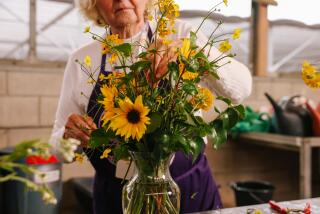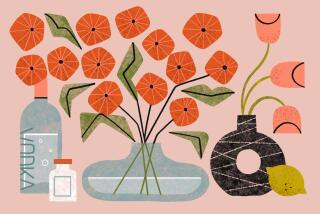Perennial Problem--Confusing Weather
- Share via
Nurseries at this point in the year can be very confusing places, as confusing as the weather this past week. With the weather it was difficult to tell whether it was spring or summer and at nurseries you’ll find a similar problem.
What you should be buying--to take home and plant for flowers this summer--is most likely not yet in flower, and really shouldn’t be. What makes it so confusing is that there are plenty of other plants in flower, mostly in quart pots, that will only last another month or so at best. These should have been planted in the fall and they are only at the nursery for those that are trying to get a little temporary color quickly, for instance in patio containers. To compound the problem, there are also some perennial flowers in bloom now that will quickly fade and then be out of flower for months, but--unlike the annual flowers--they will bloom again next year.
Look at the Labels
How do you know what should be planted now for flowers all summer, and which should be passed by unless you just want temporary color? Look at the labels and then let these lists be your guide.
What you should be planting now, for color all summer:
Ageratum
Asters (the annual kind)
Balsam
Bedding begonias (best with some shade)
Candytuft
Catharanthus (Vinca rosea)
Celosia
Coleus (best with some shade)
Cosmos
Dahlias (bedding types)
Gloriosa daisy
Impatiens (best in shade)
Marigolds
Petunias
Phlox (annual kinds)
Portulaca
Verbena
Zinnia
These may be for sale, but they are really spring flowers, and won’t last much longer:
Anemones
Calendulas
English daisies
Iceland poppies
Larkspur
Linaria
Pansies
Primroses
Ranunculus
Snapdragons
Stock
Sweet William
Violas
All of the above are annual plants, and though they may linger from one season to the next, they should really be taken out at the end of their season and new plants put in next year.
The summer flowers, from the first list, should be planted from as small a start as you can find, from little plants in packs of several. Or, even from seed sown directly in the ground. If you plant them already in flower they will not have a chance to grow a good root system and as a result you will be watering them constantly (and maybe causing them to rot in the process).
Hard to Categorize
A few annual flowers don’t fit neatly into either of the above groups. Chrysanthemum multicaule and Chrysanthemum paludosum --two tiny daisies--can be planted in the fall, or in spring, though expect them to give up the ghost when the real heat of summer arrives in July. Nasturium, lobelia and sweet alyssum can be planted at any season, though lobelia may need a little shade in hot inland gardens to bloom well in midsummer. Cinerarias flower in spring, but they are so frost sensitive that they are usually planted in very early spring--late February or March--so they miss the coldest weather. And bedding salvia, with its handsome spikes of blue flowers, can be planted at any season, as can border penstemon, columbine, coreopsis, geraniums, nicotiana and nierembergia--perennials that tend to bloom in every season but winter.
Plants in this last group are technically perennials, but are often used as if they were annual bedding plants, being planted every year in fall or spring. One other perennial that is best planted each year as if it were an annual is the delphinium. My advice here, is to plant the tall Pacific Giant types in the fall, and the shorter Blue Fountains types in very early spring, in February or early March. I wouldn’t advise planting them now, though I confess to having just done so with the Blue Fountains because I plain forgot.
Most other perennials can be planted in fall or spring, though they are going to flower in their particular season. For instance, you can plant Shasta daisies anytime but they will most likely flower in June and July.
Perennials are best bought in quart pots, though they also do reasonably well from gallon cans and there is no harm in buying these already in flower because they will be in the garden for at least several years and will bloom again when their season comes back around. In fact, buying them in flower is just about the only way you have of knowing what you are getting since most are poorly labeled and often unfamiliar.
There is one wonderful perennial you may have to look for inside the nursery--the fall-flowering Liatris . Commonly called gayfeather, tall lavender spikes grow from tuberous roots about now.






